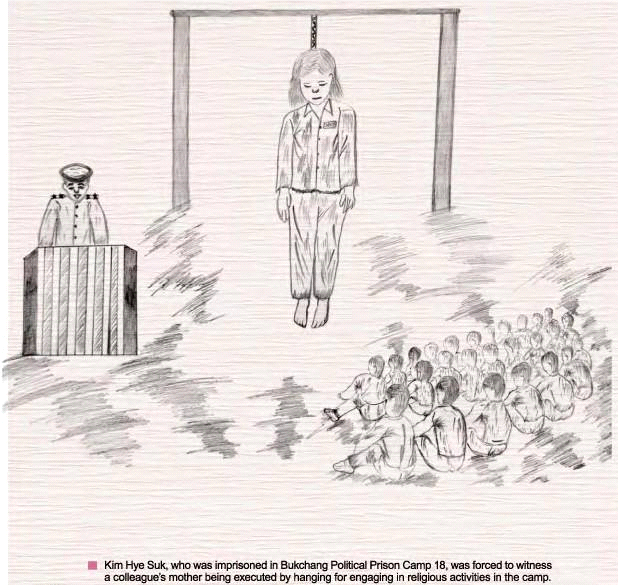|
By Grace Wright, HRNK Research Intern December 2015 “Every religious believer is regarded as being an enemy of the state, a hostile and impure element, an agent of the United States (if Christian), and a counter-revolutionary for whom only discrimination, punishment, isolation, and even execution are the proper forms of treatment by the regime”[1] While Pyongyang was once known as the “Jerusalem of the East,” today North Korea not only denies its citizens religious freedom but also actively persecutes people of faith. In fact, religious persecution has been a central part of North Korean policy since the inception of the regime. As early as before the Korean War, the government executed, exiled, and incarcerated religious individuals. Robert Collins explains, “Not only was there an effort to suppress religion from the outset of the socialist revolution, but there was a whole-scale effort to eliminate all religion and practitioners from North Korean society.”[2] One report estimates that 400,000 religious people were executed or sent to political prisons from 1958 to 1960. In 1962, Kim Il-sung announced that all clergymen above the rank of deacon had been executed and religious laypersons had been reformed through labor or imprisoned.[3] The regime’s socio-political classification system called “songbun” also targets religion. Specific songbun categories designate those who believed in Protestant Christianity, Catholicism, Buddhism, and the Chong-do religion at the end of the Korean War and their descendants. All of these groups fall into the “hostile class,” which singles them out for dangerous jobs, limited educational opportunities, less access to food, poor living conditions, special state surveillance, and harsher punishment for crimes.[4] In order to enact its brutal policy of religious persecution, the regime goes to great lengths to track down those practicing their faith in secret. The State Security Department trains its agents to infiltrate secret religious meetings, pose as religious leaders, and lure in people of faith by hosting fake religious gatherings. They then interrogate and often torture those arrested to obtain the names of other religious people.[5] North Korean escapee Jung Gwang-il recalls being imprisoned with Christians who had participated in a secret home church during his time in a kwan-li-so (political prison camp).[6] The leader of their church had been executed, and some of the more devoted members were condemned to forced labor for life. In addition to practicing religion within North Korea, converting or even having contact with Christians while in China has dire consequences for North Koreans if they are caught and forcibly repatriated. During harsh interrogations involving starvation and torture, former detainees report being asked whether they met any Christians in China or visited a Christian church. Escapees report that admitting either of these acts results in execution or imprisonment in a kwan-li-so or kyo-hwa-so (prison labor camp).[7] One former detainee recalled that “two women confessed to having converted to Christianity while in China and were taken away by police agents, who told the remaining women that the two Christian converts had been executed and that the rest of the women should consider themselves warned.”[8] Another reported, “Recently, many North Korean refugees have Bibles with them when they are repatriated. If they are caught carrying a Bible, they are punished. In North Korea, you can get away with murder if you have good connections. However, if you get caught carrying a Bible, there is no way to save your life.”[9] The Kim government targets religion because it perceives all faiths as threats to the regime’s cult of personality and totalitarian control. One escapee explains, “You can consider the entire North Korean society as some sort of religious group with the religious leader being Kim Il-sung and their Bible being the Juche or self-reliance ideology…So if the North Koreans start to realize that Kim Il-sung might not be the real god and there might be some other god out there then it’s not a good thing for the leadership.”[1]
If you are interested in learning more about religious discrimination in North Korea, please see HRNK’s Marked For Life: Songbun, North Korea’s Social Classification System, and for more information on North Korea’s prison camp system, which contains many religious prisoners, check out The Hidden Gulag, Second Edition. [1] Robert Collins, Marked for Life: Songbun, North Korea’s Social Classification System (Washington, D.C.: HRNK, 2012), 78. [2] Ibid., 78-79. [3] United Nations, General Assembly, Report of the detailed findings of the commission of inquiry on human rights in the Democratic People’s Republic of Korea, A/HRC/25/CRP.1 (February 7, 2014), 69. [4] Collins, Marked for Life, 113, 117. [5] United Nations, Report of the detailed findings, 71-72. [6] Mr. Jung was imprisoned in North Korea’s Kwan-li-so No. 15 Yodok (Camp 15). He contributed to HRNK’s report on the prison camps, entitled, The Hidden Gulag IV: Gender Repression & Prisoner Disappearances. See pages 29-30 of that report. [7] David Hawk, The Hidden Gulag Second Edition (Washington, D.C.: HRNK, 2012), 120. [8] Ibid., 137. [9] United States Commission on International Religious Freedom, A Prison Without Bars: Refugee and Defector Testimonies of Severe Violations ofFreedom of Religion or Belief in North Korea (2008), 10. [10] United Nations, Report of the detailed findings, 68.
2 Comments
Alice Cunningham
12/9/2015 11:39:48 am
Excellent article. I feel for peoples all over the world who do not have the freedom to worship. In China I worshipped with a secret church. I am sure you were outside your comfort zone much of the time.
Reply
Leave a Reply. |
DedicationHRNK staff members and interns wish to dedicate this program to our colleagues Katty Chi and Miran Song. Categories
All
Archives
June 2024
Categories
All
|

 RSS Feed
RSS Feed
